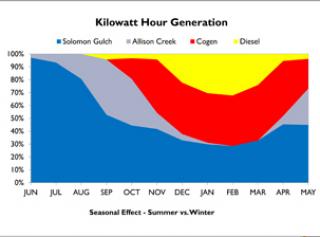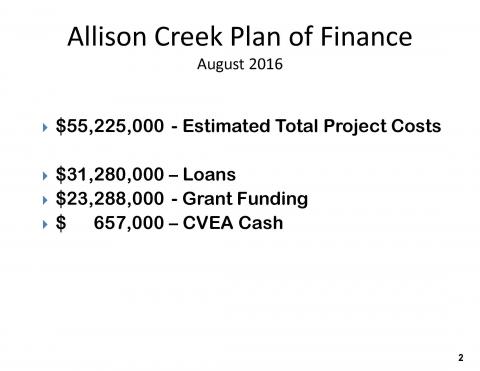The Allison Creek Hydroelectric Project will increase CVEA's renewable generation portfolio from 50 to 64 percent. The graph below shows the generation portfolio by month. The light blue color shows how Allison Creek fits into CVEA's summer and winter generation seasons. One benefit of the Allison Creek Project is that the hydroelectric season will be expanded; starting earlier in Spring and ending later into the Fall.
(click images to enlarge)
The cost of the project in 2016 dollars is approximately $55 million. The table above shows the cost breakdown of each project component.
Allison Creek will displace 15,057,000 kWhs of fossil fuel generation and will displace over 700,000 gallons of fuel annually.
The State, through direct appropriations and the Renewable Energy Fund, has committed $23 million toward the project. The balance, of $32 million, is expected to be funded from debt. Borrowing capacity of $35.0 million is already in place for costs not paid through grants.
Roughly 42 percent of this project has been grant funded.
There are many benefits of the Allison Creek Project. It's renewable; displaces fuel leading to reduced emissions; saves customers money; and provides additional energy for increased loads and to protect against low water years at Solomon Gulch.
The slide above demonstrates the benefits under two scenarios: a normal water year and a low water year.
- In a normal water year, CVEA will produce approximately 44 million kWhs out of Solomon Gulch and 15 million kWh's out of Allison Creek making hydro 59 million kWhs on CVEA's system, or 64 percent of our power generation requirement.
- As CVEA produces fewer kWh's with fuel, this results in reduced emissions. Under this scenario, CVEA will reduce fuel gallons by 725,000. At $60/barrel, this equates to a 1.7 million dollar savings. The fixed annual costs of Allison is $2.4 million. In a normal water level year, the cost to members would be $714,500. That number divided by the 80 million kWh's CVEA sells, equates to a .89 cent cost per kWh.
- In a low water year we are able to utilize more Allison power thus reducing more gallons of diesel, further reducing emissions and saving more fuel dollars.
Allison is capable of producing 23 million kWhs annually. If we can find a market for the surplus energy, savings to customers can be increased further.




